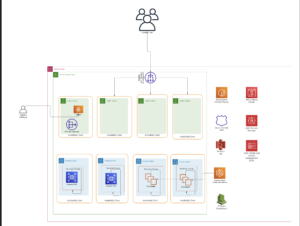About Client
IAMPASS
An intuitive, adaptive identity and access framework—lets users make transactions, engage in content, and safely navigate online without needing tokens, passwords, or links.
The company is on a mission to make being online safe— protecting identity and access by blurring the lines between connected and offline worlds and building a future where online presence is highly secure yet simple.
The Challenge
As IAMPASS developed the front end of its next-generation, AI-based digital identity solution, CEO Carey D’Souza knew the next key step was to design and deploy an enterprise-grade application infrastructure.
“As our customer base grows and we onboard large customers, we need to make sure our solution remains resilient,” D’Souza explains. “When the workload increases, we can’t allow the performance of the application to degrade.”
The IAMPASS IT team had already built an application infrastructure on the Amazon Web Services (AWS) cloud platform. But the complexity of an infrastructure that includes the implementation of a server cluster that can scale automatically would require a higher level of expertise.
“The bandwidth of our internal resources was also limited,” adds D’Souza. “We need to keep them focused on further developing the core services of our solution to increase the value of what we provide to our customers.”
“Infrastructure-as-code environment enables application performance to scale while also accelerating code update deployments”
The Solution
As IAMPASS developed the front end of its next-generation, AI-based digital identity solution, CEO Carey D’Souza knew the next key step was to design and deploy an enterprise-grade application infrastructure.
“As our customer base grows and we onboard large customers, we need to make sure our solution remains resilient,” D’Souza explains. “When the workload increases, we can’t allow the performance of the application to degrade.”
The IAMPASS IT team had already built an application infrastructure on the Amazon Web Services (AWS) cloud platform. But the complexity of an infrastructure that includes the implementation of a server cluster that can scale automatically would require a higher level of expertise.
“The bandwidth of our internal resources was also limited,” adds D’Souza. “We need to keep them focused on further developing the core services of our solution to increase the value of what we provide to our customers.”
To take on this challenge, D’Souza consulted with AWS, a vital cloud partner that has developed a trusted relationship. Realizing the criticality of enabling IAMPASS to build an enterprise application infrastructure quickly, AWS referred D’Souza to Avahi Technologies.
“With how Avahi impressed us during the initial meeting, we did not consider collaborating with anyone else,” says D’Souza.
Avahi impressed D’Souza and the senior leadership team by asking the right questions to understand the IAMPASS requirements. The Avahi team also demonstrated how it has helped many other start-up companies build an application infrastructure and presented a game plan on how to complete the project in six weeks.
“If we had attempted to hire someone to handle the project, it would take at least four months,” D’Souza says. “And we would have assumed a certain amount of risk as to whether they could complete the project. Avahi brings the necessary resources to the table right away, and their range of cloud skills gave us confidence they could do the job.”
Results
To automate DevOps, Avahi used the Terraform tool to set up an Amazon Elastic Kubernetes Service (EKS) cluster within an infrastructure-as-code environment. IAMPASS can also easily deploy application updates through an automated Argo CI/CD pipeline created by Avahi. When IAMPASS brings on a new customer, the microservices codebase of the infrastructure remains constant so that IAMPASS only has to change the variables pertaining to each customer.
The infrastructure, which meets the requirements of the AWS Well-Architected framework, is deployed in multiple AWS availability zones, making it highly scalable and resilient with failover disaster recovery capabilities. IAMPASS customers can connect to Linux Bastion servers and their respective databases in the infrastructure through a virtual private network.
Shortly after Avahi completed the scalable application infrastructure to support the digital identity solution, IAMPASS provided a demonstration to an enterprise customer and was able to close on the deal. Two additional large companies were close to becoming customers as well.
“The speed in which Avahi designed and deployed the solution is key,” D’Souza emphasizes. “This allowed us to go to market at an enterprise level and start generating new revenue streams earlier.”
The IAMPASS developer team has also benefitted from working with Avahi, gaining a stronger understanding of how cloud infrastructure resources function. The two teams devised a way for the front-end application and the back-end infrastructure to exchange data more efficiently.
“We now have a cloud partner we can keep going back to as we have questions about how to enable our applications to run more efficiently in the cloud,” says D’Souza. “Avahi also passed along its cloud management knowledge and detailed documentation on the infrastructure so that in the short term, we can manage the AWS environment on our own. But as we grow, we are likely to bring Avahi back in for more help.”
“The speed in which Avahi designed and deployed the solution is key. This allowed us to go to market at an enterprise level and start generating new revenue streams earlier.”
Carey D’Souza
CEO of IAMPASS
Key Challenges
- Accelerate deployment of enterprise-grade application infrastructure.
- Build architecture to support anticipated heavy application workloads.
- Avoid using internal resources on the project so they continue to focus on software development.
- Accelerate code deployments.
Key Results
- Allowed internal resources to focus on front-end application development.
- Accelerated the infrastructure deployment time compared to hiring internal resources.
- Supported successful demos for initial enterprise customers.
- Enabled application performance to scale as new customers are onboarded.
- Implemented CI/CD pipeline to speed up front-end application code updates.
- Provided knowledge transfer and documentation so internal team can handle shortterm support.
- Created a trusted partnership to leverage for future cloud expertise requirements.
Key Technologies
- Amazon Elastic Kubernetes Service (EKS)
- Amazon Elastic Container Registry (ECR)
- AWS Certificate Manager (ACM)
- AWS Secrets Manager
- Amazon Simple Storage Service (S3)
- Amazon Identity and Access Manager (IAM)
- Amazon Route 53
- Amazon CloudWatch
- AWS Lamba
- Terraform
- Argo
- Linux Bastion
Solution Architecture Diagrams





